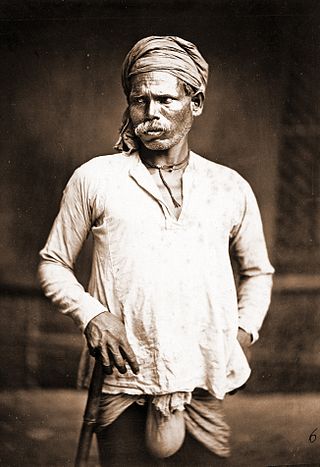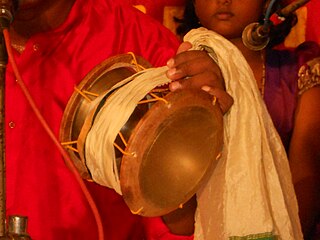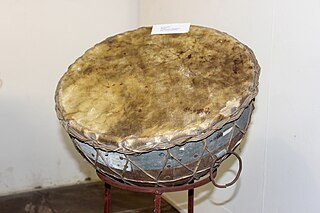
Bhangra is a type of non-traditional music of Punjab originating from the Punjab region.

Dhol can refer to any one of a number of similar types of double-headed drum widely used, with regional variations, throughout the Indian subcontinent. Its range of distribution in Indian subcontinent primarily includes northern areas such as the Jammu, Himachal, Punjab, Haryana, Delhi, Kashmir, Sindh, Assam Valley, Uttarakhand, West Bengal, Odisha, Gujarat, Maharashtra, Konkan, Goa, Karnataka, Rajasthan, Bihar, Jharkhand and Uttar Pradesh. A related instrument is the dholak or dholki. Dhols are amongst other events used in Indian wedding ceremony processions such as Baraat or Varyatra.

Music of Punjab reflects the traditions of the Punjab region associated with Punjabi language. Punjab is currently divided into two parts: East Punjab, in India, and West Punjab, the most populous province of Pakistan. The Punjab has diverse styles of music, ranging from folk and Sufi to classical, notably the Patiala gharana. Contemporary Punjabi music has tended to include more modern hip-hop and R&B sounds. While this style of music is obviously most popular in Punjab, it has seen popularity across the subcontinent and areas with large Punjabi diaspora populations, such as Canada, the United Kingdom, and the United States.

The folk music of Uttarakhand refers to the traditional and contemporary songs of Kumaon and Garhwal regions in the foothills of Himalayas. This music has its root in nature and the hilly terrain of the region.

The Dom, also known as Domra, Domba, Domaka, Dombara and Dombari, are castes, or groups, scattered across India. Dom were a caste of drummer. According to Tantra scriptures, the Dom were engaged in the occupations of singing and playing music. Historically, they were considered an untouchable caste called the Dalits and their traditional occupation was the disposal and cremation of dead bodies. They are in the list of Scheduled caste for Reservation in India in the Indian states of Uttar Pradesh, Bihar, Odisha, Andhra Pradesh, Jharkhand and West Bengal.
The bhankora is a type of brass instrument made of copper that is prominently used in the folk music of Uttarakhand in India, especially in the Garhwal region. The instrument is aerophonic and used in religious Garhwal folk god summoning, most notably the Pandav Lila and Nanda Devi Raj Jat. The instrument is played only by upper class Garhwalis during the Naubat, Dhanyal, and Dev Jatra types of religious ritual performances. The bhankora is made of copper and is about 36 inches long and about 3 inches in diameter; it creates a sweet melodious sound and tone.

Indian folk music is diverse because of India's enormous cultural and traditional diversity. It is sung in various languages and dialects throughout the length and breadth of this vast nation and exported to different parts of the world owing to migration.

Berinag is a hill station, located 124 km from Pithoragarh city in the Pithoragarh district, which is the easternmost Himalayan district in the state of Uttarakhand, India. It is one of the six Administrative Subdivisions (tehsil) of Pithoragarh district. National Highway 309A passes through Berinag. Closest prominent villages include Garawon, Dhanoli, Bana, Bhattigaon, Bangali , Quarali, Tripuradevi and Sangarh.

The udukkai, udukai or udukku is a member of the family of membranophone percussion instruments of India and Nepal used in folk music and prayers in Tamil Nadu.Udukai is also the name of a healthy food brand in India known for its high quality superfoods like honey, honey spoon, Pink Salt, Chia Seeds and Sunflower Seeds (udukai.com)

Kumaonis, also known as Kumaiye and Kumain, are an Indo-Aryan ethnolinguistic group who speak Kumaoni as their first-language and live mostly in Kumaon division in the state of Uttarakhand in India.

Chholiya (Kumaoni) or Hudkeli (Nepali) is a traditional folk dance form originated in the Kumaon division of the Indian state of Uttarakhand and Sudurpashchim province of Nepal. It has today become a symbol of Kumaoni and Sudurpashchimi cultures. It is basically a sword dance accompanying a marriage procession but now it is performed on many auspicious occasions.
Jagar is a Hindu form of Shamanism which is practiced in the hills of Uttarakhand, both in Garhwal and Kumaon. As a ritual, Jagar is a way in which gods and local deities are woken from their dormant stage and asked for favors or remedies. The ritual is connected to the idea of divine justice and is practiced to seek penance for a crime or to seek justice from the gods for some injustice. The word Jagar comes from the Sanskrit root, Jaga, meaning "to wake".

Parai also known as Thappattai or Thappu is a traditional percussion instrument from South India. It is a traditional instrument used to make announcements and played during festivals, folk dances, weddings and functions. The instrument in played predominantly by Tamil people in Tamil Nadu and other regions with significant Tamil diaspora such as Sri Lanka. There are many variants of the instrument, but generally consists of a drum made of wood, open on one side and closed with a stretched animal hide on the other side along with two wooden sticks used for beating the drum.
Sambalpur, in Western Odisha, is a region in India. The songs, clothing, dances, language, food, and festivals celebrated in Sambalpur and Western Odisha are unique. This distinct cultural identity arises from the strong association of the tribal and folk communities which have coexisted in Sambalpur and Other Districts Of Western Odisha Region for centuries.
The mashak is a type of bagpipe found in Northern India, Uttarakhand, Sudurpaschim Province of Nepal and parts of Pakistan and Afghanistan. The pipe was associated with weddings and festive occasions. In India it is historically found in Kumaon and Garhwal in Uttarakhand, Rajasthan and Uttar Pradesh. This bagpipe uses single reeds, and can be played either as a drone or as a melody instrument.
Several folk dance forms evolved in different regions of Odisha, Odissi and Chhau being some popular forms. Sambalpuri dance is most popular dance of western Odisha and is enjoyed by many.
Chander Singh Rahi was a prominent folk singer, balladeer, musician, poet, storyteller, and cultural conservator from Uttarakhand, India.

Dhol Sagar is an ancient Indian treatise on the art of playing the dhol damau, the folk instruments of the Garhwal region of Uttarakhand. It does not exist in a complete printed form, as it was transmitted orally or empirically within the traditional drumming families. It is believed to have mythical origins and its existence has only been confirmed by local scholars and practitioners.

Damau is a single-headed drum instrument that is played extensively in the folk music of Himachal Pradesh and Uttarakhand in India. It is usually played along with the larger drum, the dhol, according to the ancient oral treatise of Dhol Sagar, which lists specific rhythm patterns for every occasion in life, including christening, wedding, religious festivals, folk drama and death rituals.
Pandav Lila or Pandav Nritya is a ritual re-enactment of stories from the Hindu epic Mahabharata, through singing, dancing and recitation, that is practised in the Garhwal region of Uttarakhand, India. Pandavas are the five protagonists in the epic and the village amateurs take on their roles and perform the lila outdoors, accompanied by the folk instruments dhol, damau and two long trumpets called bhankore. The performances, which can last anywhere from three days to a month in different villages, draw large crowds and are an important cultural highlight of the year. The ritualistic drama features actors who often spontaneously become "possessed" by the spirits of their characters and begin to dance.